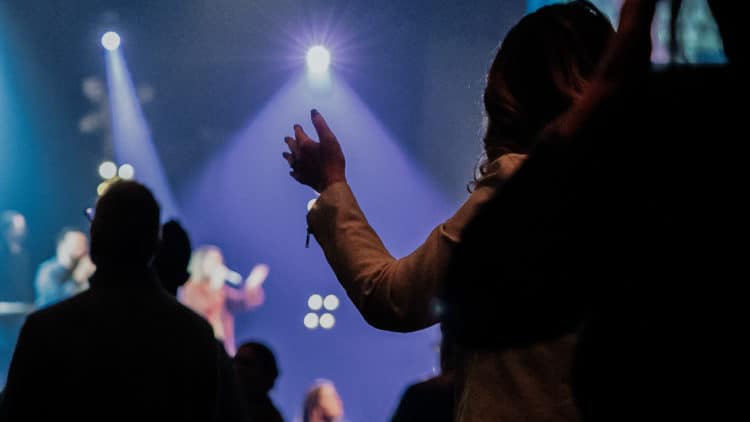Christmas Eve Is Almost Here! Let Us Know You're Coming!
The Cure for Loneliness & Crooked Wall Art
September 26, 2025
Have you ever started a project and realized part-way through that you were missing an important tool to get the job done? Maybe instead of going to get the right tool, you’ve tried to forge ahead, MacGyver’ing the wrong tool for the task — leveling a picture frame with a fork, mixing concrete for your new back patio in a kiddy pool, or towing something heavy with fishing line. The point here is obvious: using tools or machinery to do what they weren’t designed for is a recipe for low efficacy, high frustration, and oftentimes…a mess to clean.
In the same way, human beings weren’t designed for life in isolation.
From the God who made us to the garden where He placed us and the eternal kingdom that awaits us, again and again we can see that we were made for community. Let’s take a closer look:

COMMUNITY → IN THE GODHEAD
If you really want to understand what a tool was made for, the best thing you can do is learn the tool’s origin story — to go back to the beginning and hear from its creator about why they made it and designed it the way they did. What problem(s) were they trying to solve? What motivated them? What end-result(s) did they have in mind? Likewise, a significant clue that we were created for community comes from our own origin story, best told by our Creator.
“In the beginning…God said, ‘Let us make man in our image, after our likeness’.” – Genesis 1:1, 26a
“In the beginning was the Word, and the Word was with God, and the Word was God.He was in the beginning with God…And the Word became flesh and dwelt among us…” – John 1:1–2, 14
“And when Jesus was baptized, immediately he went up from the water, and behold, the heavens were opened to him, and he saw the Spirit of God descending like a dove and coming to rest on him; and behold, a voice from heaven said, ‘This is my beloved Son, with whom I am well pleased’.” – Matt. 3:16–17
Throughout Scripture, the Trinitarian nature of God — namely that He is somehow simultaneously Father, Son, and Spirit — is apparent (Gen. 1:1–2, 26a; Is. 48:16; Matt. 28:19; Jn. 1:1–3, 14; 2 Cor. 13:14; Rev. 1:4–5; etc.). We also see that, of all God created, human beings were uniquely made to bear the image and likeness of their Creator: a Being who, in and of Himself is ever-existent in community.
In John 17, Jesus prays for all who would call themselves His disciples, asking the Father to grant them the same oneness — or community — that He and the Father shared. If God exists in eternal community with Himself, and if we were made with the purpose (or at least a purpose) of reflecting His image, logic alone could conclude that we were made to be in community. But we don’t have to guess. God makes this very clear in Genesis chapter two.
COMMUNITY → IN THE GARDEN
“The Lord God took the man and put him in the garden of Eden to work it and keep it…Then the Lord God said, ‘It is not good that the man should be alone; I will make him a helper fit for him’…So the Lord God caused a deep sleep to fall upon the man, and while he slept took one of his ribs and closed up its place with flesh. And the rib that the Lord God had taken from the man he made into a woman and brought her to the man…and they shall become one flesh.” – Gen. 2:15, 18, 21–22, 24b
God called everything that He had made in all of creation “good,” until a single human being existed in isolation. This, He clearly said, was “not good.” God knew that existing as His image-bearers meant that we would need to exist together. Furthermore, after God made Adam and Eve, He blessed them and bestowed upon them what is known as The Creation Mandate. This blessing and mandate included that they should be fruitful and multiply — something no human being could fulfill on his or her own. So, not only is God communal in nature, but we now see that the two very first humans were specifically created to thrive in community, as well as add to it. In addition to inference, we’ve now heard from the Creator Himself that it is not good for man to be alone. It wasn’t what He designed us for.
COMMUNITY → IN GLORY
So far, we’ve looked at two compelling pieces of evidence for our communal makeup: the nature of the triune God who created us and the actual words He spoke about humanity in the biblical creation account. But creation wasn’t the only time God declared our identity as communal. Explicitly and implicitly, this idea is woven throughout the entirety of Scripture, presented as something we’re meant to display now and fully experience in glory.
From the beginning, God has pursued a relationship with His chosen people (plural) — not person (singular) — and He has continuously displayed his intent to dwell WITH us. As if taking up temporary residence, God has manifested His presence in temples, burning bushes, in pillars of cloud and fire, on mountains, in fiery furnaces, through angelic appearances, and in visions. All the fullness of God was pleased to indwell the long-awaited Messiah — Jesus of Nazareth — who dwelt among His people in bodily form (Jn 1:14; Col. 1:15–20). After Jesus died, arose, and ascended into Heaven, He sent His Holy Spirit to indwell the souls of His people — those who profess His name (Jn. 14:16–17; Acts 2:1–4, 38; 1 Cor. 3:16; 1 Cor. 6:19). Then, in a prophetic text at the climax of the biblical narrative, God declares once and for all that “…the dwelling place of God is with man. He will dwell with them, and they will be his people, and God himself will be with them as their God.” (see Rev. 21:1–4).
→ Of course, the idea that God will dwell with His people assumes that His people will dwell with each other, that is, in community.
“For as in one body we have many members, and the members do not all have the same function, so we, though many, are one body in Christ, and individually members one of another.” – Romans 12:4–5
In glory, when Christ returns — when all is made right and new — people from every tribe, nation, and tongue will be gathered to Him and, therefore, to one another. They will dwell with Him and worship Him face-to-face in a communal worship gathering like nothing we’ve ever seen or could possibly conceive (Rev. 7:9–12). But even now, in the in-between, we not only have a natural identity of community but a holy calling to live as such. Hear, O Church, the Word of the Lord:
“Let love be genuine. Abhor what is evil; hold fast to what is good. Love one another with brotherly affection. Outdo one another in showing honor…Contribute to the needs of the saints and seek to show hospitality…Rejoice with those who rejoice, weep with those who weep. Live in harmony with one another…If possible, so far as it depends on you, live peaceably with all.” – Rom. 12:9–10, 13, 15–16a, 18
“Bear one another’s burdens, and so fulfill the law of Christ.” – Gal. 6:2
“And let us consider how to stir up one another to love and good works, not neglecting to meet together, as is the habit of some, but encouraging one another, and all the more as you see the Day drawing near.” – Heb. 10:24–25
→ Not connected to Christ-centered community? That can change today.
- If you live in the Metro Detroit area, come check out one of our Woodside Bible Church locations.
- If you’re already part of the Woodside community but not yet part of a Life Group, check out our group finder.
→ Want to dig deeper on this topic? Check out these other great resources:
BOOKS:
Life Together —Dietrich Bonhoeffer
The Life We’re Looking For — Andy Crouch
PODCASTS:
Community 01: Rediscovering Jesus’ Vision for Family — Rule of Life
The Danger of Deserting Community — Ask Pastor John
Building Deep Community in a Lonely World — TCG
SERMONS:
The New Community — Timothy Keller
Enlightened Together— Alistair Begg
Follow our “In Christ” sermon series at Woodside
